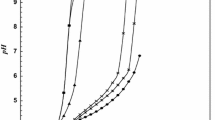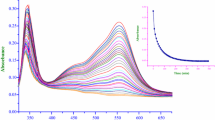Abstract
The complexation equilibria of Fe(III) with two buffer families, which are ubiquitous in biological system studies, were studied by potentiometric measurements at a constant ionic strength of I = 0.1 mol·dm−3 NaNO3 in aqueous solutions at 298.15 K. The members of TRIS family are tris(hydroxymethyl)aminomethane (TRIS), N-[tris(hydroxymethyl)methyl]-2-aminoethanesulfonic acid (TES), N-[tris(hydroxymethyl)methyl]-3-aminopropanesulfonic acid (TAPS), N-[tris(hydroxymethyl)methyl]-3-amino-2-hydroxypropanesulfonic acid (TAPSO), and N-tris(hydroxymethyl)methyl-4-aminobutanesulfonic acid (TABS) buffers. The members of morpholine family are 4-morpholineethanesulfonic acid (MES), 4-morpholinepropanesulfonic acid (MOPS), 3-morpholino-2-hydroxypropanesulfonic acid (MOPSO), and 4-(N-morpholino) butanesulfonic acid (MOBS) buffers. The overall stability constants were determined from pH-metric data using the least-squares curve-fitting program HYPERQUAD 2008. Based on the best-fit results, the species formed at equilibrium are ML, ML2, ML2H−1, and ML3 in the systems with TRIS family buffers. The complex species ML, ML2, ML2H−1, and MLH−1 are formed in the MOPSO-containing system, while ML, ML2, and ML2H−1 are formed in the systems with MES, MOPS, and MOBS. The stabilities of the complexes fall in the order TABS > TRIS > TAPS > TAPSO > TES and MOBS > MOPS > MOPSO > MES for the TRIS family and morpholine families, respectively.





Similar content being viewed by others
References
Good, N.E., Winget, G.D., Winter, W., Connolly, T.N., Izawa, S., Singh, R.M.M.: Hydrogen ion buffers for biological research. Biochemistry 5, 467–477 (1966)
Ferguson, W.J., Braunschweiger, K.I., Braunschweiger, W.R., Smith, J.R., McCormick, J.J., Wasmann, C.C., Jarvis, N.P., Bell, D.H., Good, N.E.: Hydrogen ion buffers for biological research. Anal. Biochem. 104, 300–310 (1980)
Good, N.E., Izawa, S.: Hydrogen ion buffers. Methods Enzymol. 24, 53–68 (1972)
Lubas, W.A., Spiro, R.G.: Evaluation of the role of rat liver endo-α-mannosidase in processing N-linked oligosaccharides. J. Biol. Chem. 263, 3990–3998 (1988)
Kameoka, D., Masuzaki, E., Ueda, T., Imoto, T.: Effect of buffer species on the unfolding and the aggregation of humanized IgG. J. Biochem. 142, 383–391 (2007)
Pedrotti, B., Soffientini, A., Islam, K.: Sulphonate buffers affect the recovery of microtubule-associated proteins MAP1 and MAP2: evidence that MAP1A promotes microtubule assembly. Cell Motil. Cytoskeleton 25, 234–242 (1993)
Arnold, F.H., Zhang, J.H.: Metal mediated protein stabilization. Trends Biotechnol. 12, 189–192 (1994)
King, N.M., Elkins, K.M.: Reactivity of the invariant cysteine of silver hake parvalbumin (Isoform B) with dithionitrobenzoate (DTNB) and the effect of differing buffer species on reactivity. J. Inorg. Biochem. 76, 175–185 (1999)
Wariishi, H., Valli, K.: Manganese(II) oxidation by manganese peroxidase from the basidiomycete phanerochaete chrysosporium. Kinetic mechanism and role of chelators. J. Biol. Chem. 267, 23688–23695 (1992)
Anwar, Z.M., Azab, H.A.: Ternary complexes in solution: comparison of the coordination tendency of some biologically important zwitterionic buffers toward the binary complexes of some transition metal ions and some amino acids. J. Chem. Eng. Data 44, 1151–1157 (1999)
Azab, H.A., Orabi, A.S., Abdel-Salam, E.T.: Role of biologically important zwitterionic buffer secondary ligands on the stability of the mixed ligand complexes of divalent metal ions and adenosine 5’-mono-, 5′-di-, and 5′-triphosphate. J. Chem. Eng. Data 46, 346–352 (2001)
Taha, M., Khalil, M.M.: Mixed ligand complex formation equilibria of cobalt-, nickel-, and N, N-bis(2-hydroxyethyl)glycine copper(II) with bicine and some amino acids. J. Chem. Eng. Data 50, 157–163 (2005)
Azab, H.A., Deghaidy, F.S., Orabi, A.S., Farid, N.Y.: Comparison of the effectiveness of various metal ions on the formation of the ternary complexes containing adenosine 5′-mono-, 5′-di-, and 5′-triphosphate and some zwitterionic buffers for biochemical and physiological research. J. Chem. Eng. Data 45, 709–715 (2000)
Khalil, M.M., Radalla, A.M., Mohamed, A.G.: Potentiometric investigation on complexation of divalent transition metal ions with some zwitterionic buffers and triazoles. J. Chem. Eng. Data 54, 3261–3272 (2009)
Anwar, Z.M., Azab, H.A.: Role of biologically important zwitterionic buffer secondary ligands in the stability of the ternary complexes containing some metal ions and guanosine 5′-monophosphate, inosine 5′-monophosphate and cytidine 5′-monophosphate. J. Chem. Eng. Data 46, 34–40 (2001)
Taha, M., Khalil, M.M., Mohamed, S.A.: Metal ion-buffer interactions: complex formation of [N, N-bis-(2-hydroxyethyl)glycine] (bicine) with various biologically relevant ligands. J. Chem. Eng. Data 50, 882–887 (2005)
Anwar, Z.M., Azab, H.A.: Ternary complexes formed by trivalent lanthanide ions, nucleotides, and biological buffers. J. Chem. Eng. Data 46, 613–618 (2001)
Taha, M., Saqr, R.A., Ahmed, A.T.: Thermodynamic studies on complexation of divalent transition metal ions with some zwitterionic buffers for biochemical and physiological Research. J. Chem. Thermodyn. 39, 304–308 (2007)
Azab, H.A., Abou El-Nour, K.M., Sorror, S.H.: Metal ion complexes containing dipeptides, tripeptides, and biologically important zwitterionic buffers. J. Chem. Eng. Data 52, 381–390 (2007)
Magyar, J.S., Godwina, H.A.: Spectropotentiometric analysis of metal binding to structural zinc-binding sites: accounting quantitatively for pH and metal ion buffering effects. Anal. Biochem. 320, 39–54 (2003)
Taha, M., Gupta, B.S., Lee, M.J.: Complex equilibria in aqueous solution of chromium(III) with some biological buffers. J. Chem. Eng. Data 56, 3541–3551 (2011)
Gans, P., O’Sullivan, B.: GLEE, A new computer program for glass electrode calibration. Talanta 51, 33–37 (2000)
Gans, P., Sabatini, A., Vacca, A.: Investigation of equilibria in solution: determination of equilibrium constants with the HYPERQUAD suite of programs. Talanta 43, 1739–1753 (1996)
Alderighi, L., Gans, P., Ienco, A., Peters, D., Sabatini, A., Vacca, A.: HYPERQUAD simulation and speciation (HySS): a utility program for the investigation of equilibria involving soluble and partially soluble species. Coord. Chem. Rev. 184, 311–318 (1999)
Gil, R., Corbillón, M.S., Olazabal, M.A., Madariaga, J.M.: Potentiometric study of the protonation equilibrium of tris(hydroxymethyl) aminomethane in aqueous sodium perchlorate solutions at 25 °C: construction of a thermodynamic model. Talanta 44, 891–896 (1997)
Goldberg, R.N., Kishore, N., Lennen, R.M.: Thermodynamic quantities for the ionization reactions of buffers. J. Phys. Chem. Ref. Data 31, 231–370 (2002)
Machado, C.M.M., Cukrowski, I., Gameiro, P., Soares, H.M.V.M.: Challenges in modeling and optimisation of stability constants in the study of metal complexes with monoprotonated ligands Part I: a glass electrode potentiometric and polarographic study of Cu–TAPSO–OH System. Anal. Chim. Acta 493, 105–119 (2003)
Roy, R.N., Roy, L.N., Grant, J.G., Cummins, M.P., Tabor III, B.J., Richard, S.J., Himes, C.A., Lively, B.R., Blackwell, P.L., Simon, A.N.: Second dissociation constants of 4-[N-morpholino]butanesulfonic acid and N-[2-hydroxyethyl]piperazine-N’-4-butanesulfonic acid from 5 to 55 °C. J. Solution Chem. 31, 861–873 (2002)
Kotila, S., Valkonen, J.: Copper(II) complexes of 2-amino-2-hydroxymethyl-1, 3-propanediol. Part 4. Synthesis, structure and thermal behavior of trans-bis [2-amino-2-hydroxymethyl-1, 3-propanediolato-O, N] copper(II) potassium fluoride and bromide, [Cu(C4H10NO3)2KF·3H2O and [Cu(C4H10NO3)2]KBr·2H2O. Acta Chem. Scand. 48, 312–318 (1994)
Yang, F., Wu, Z.H., Cai, J.H.: Catena-poly[nickel(II)-bis(μ-2-aminoethanesulfonato-k3 N, O:O’:k3O:N, O’)]. Acta Crystallogr. Sect. E 66, 748 (2010)
Yang, F., Liu, X.H., Zhao, C.Q.: Catena-poly[cobalt(II)-bis(μ-2-aminoethanesulfonato)-k3 N, O:O’;k3O:N, O’]. Acta Crystallogr. Sect. E 66, 1343–1344 (2010)
Cai, J.H., Jiang, Y.M., Wang, X.J., Liu, Z.M.: Bis(μ-2-aminoethanesulfonato)- k3 N, O:O’;k3O’:N, O-bis[bipyridine-k2 N, N(perchlorato-Ko)copper(II)]. Acta Crystallogr. Sect. E 60, 1659–1661 (2004)
Acknowledgments
The authors are grateful for financing provided by the National Science Council, Taiwan, through Grant No. NSC99-2811-E-011-023. MT acknowledges a postdoctoral fellowship through this grant. BSG also thanks the scholarship from National Taiwan University of Science & Technology. The authors also thank Dr. Ho-mu Lin for valuable discussions.
Author information
Authors and Affiliations
Corresponding author
Rights and permissions
About this article
Cite this article
Gupta, B.S., Taha, M. & Lee, MJ. Stability Constants for the Equilibrium Models of Iron(III) with Several Biological Buffers in Aqueous Solutions. J Solution Chem 42, 2296–2309 (2013). https://doi.org/10.1007/s10953-013-0107-6
Received:
Accepted:
Published:
Issue Date:
DOI: https://doi.org/10.1007/s10953-013-0107-6




